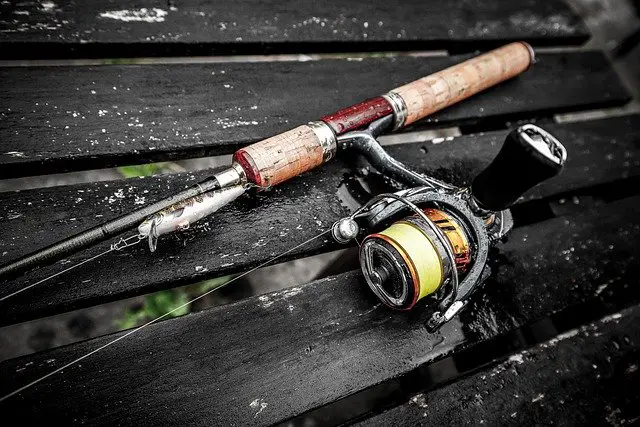
When you think of bass fishing, you think of baitcasters. However, Spinning reels have their place if used for the correct application.
Spinning reels are suitable for bass fishing. Spinning reels can be used for bass fishing and play a valuable role when using lighter tackle or lighter line because they can cast smaller baits and line more easily than a baitcaster. Spinning reels are best for finesse fishing for bass.
Knowing the correct times to use a spinning reel can make a “reel” difference in your fishing success. Read on for specific ways to use spinning reels to catch more fish, including a surprise technique nobody talks about.
Why Use a Spinning Reel for Bass Fishing
Veteran bass fishermen use spinning reels for different reasons. The situation dictates the need for spinning reels. When deciding between a baitcaster and a spinning reel, anglers must consider their bait or lure and the particular technique they will employ for catching fish on a given day.
Many fishermen initially choose spinning reels because they are easier to learn how to use than a baitcaster. In addition, spinning reels are known for their relative simplicity. Therefore, most newcomers to fishing opt for a spinning reel when starting, then add baitcasting reels later.
The Difference Between Spinning and Baitcasting Reels?
Baitcasters differ from spinning reels for various reasons, including spool-to-rod orientation and casting methods. For example, baitcasters sit on the top side of a rod, and the spool of a baitcaster is parallel to the rod. On the other hand, spinning reels sit on the bottom side of the rod, and the spool of a spinning reel is at a right angle to the rod.
You cast a spinning reel by flipping the bail, holding the line with your finger, and then letting go to cast. To reel in, close the bail and turn the reel handle. To cast a baitcaster, you disengage the reel lock by pressing a button. Next, you hold tension on the spool with your thumb. Cast the lure by releasing your thumb from the spool. Apply pressure with your thumb as the lure lands or approaches the water. Finally, turn the handle to reel in.
When Should You Use a Spinning Reel for Bass Fishing?
The decision to use a spinning reel over a bait caster typically depends on a shortlist of variables, including line size, bait selection, and technique. Baitcasters are built to accommodate power styles of fishing. Spinning reels are typically used more for finesse fishing styles, although there is a growing trend to use them for some topwater baits.
When fishing in clear or highly pressured bodies of water, conventional wisdom is to use a more subtle technique, which means using a lighter line so the fish don’t see the line as easily. The more natural your presentation in these conditions, the better your chances of catching fish.
Finesse fishing for bass using spinning reels is a go-to tactic for many professional bass fishermen, such as Kevin Van Dam, Scott Martin, and Jacob Wheeler, to name a few. They lean on this technique, especially when bass don’t want to bite.
Mike Iaconnelli, Bassmaster Angler of the Year and Classic Winner, when talking about the benefits of using lighter tackle and finesse fishing, had this to say,
“ … but the technique really out-shines other presentations in generating feeding strikes because you can make your lure look more natural so it doesn’t make a bass back away.” (Bassmaster.com)
The Abu Garcia Elite Max is a killer all-around spinning reel—smooth, lightweight, and perfect for finesse bass tactics: Abu Garcia Elite Max Spinning Reel
Pros and Cons of Spinning Reels for Bass Fishing
Pros
- Spinning reels are generally easier to use.
- Can spool with lighter line.
- Better for smaller, lighter baits.
- The drag system is easier to manage during a catch.
- Much easier to cast into the wind without risking a backlash.
- Can be better for skipping a bait or lure because backlash is not a risk.
- No swing back or “penduluming” as the bait falls. While using a baitcaster, when your bait hits the water, it may not fall directly onto a target because of the resistance (friction) inherent to a baitcaster. Spinning reels allow a better free fall, so your bait may reach its mark more easily.
Cons
- Doesn’t handle heavier lines as, well.
- Usually has lower gear ratios, so not as effective for certain bass fishing techniques (flipping, punching, and bigger baits and lures).
- Does not pick up (reel in) the line as fast as a baitcaster.
- Line twist and tangles can be a problem.
- Harder to stop the bait at your target than a baitcaster. With a baitcaster, you can use your thumb to stop your lure as it approaches a target, whereas you’ll need to employ a more difficult feathering technique with a spinning reel.
What Size Spinning Reel for Bass Fishing?
There are several size options to choose from when deciding what size spinning reel to use for bass fishing. Some companies use a 4-digit number (1000, 2000, 2500, 3000, 3500. etc/) while others use two digits (10, 20, 25, 30, 35, etc.) to designate reel sizes. Smaller numbers mean smaller reel sizes.
Important questions must be answered before deciding on the right size for your bass fishing reel. Consider the size of the potential catch and the bait and technique you’ll be using. Smaller baits and smaller fish usually mean smaller reels, whereas larger applications and fish mean larger reels. “30” reels are among the most common and versatile for most bass fishing situations.
However, well-known professional bass fisherman Kevin Van Dam proposes using larger spinning reels as much as possible. He advocates larger reels because he believes that larger reels may help with line management and fewer tangles. Additionally, he notes that larger spinning reels allow an angler to cast farther with less effort. Finally, Van Dam feels that larger reels allow for picking up (reeling in) the line faster. He doesn’t feel like the bigger reel is the answer for every situation but does encourage using a larger reel when possible. He quickly points out that you should consider the reel’s weight when deciding between a “30” reel and a bigger reel like a “40”. Be sure you are comfortable with the heaviness of the reel.

What Line to Use on a Spinning Reel for Bass Fishing
Like rod and reel setup decisions, line choice depends on what lures you are fishing, your technique, and the cover you are working around during your day. Monofilament, fluorocarbon, and braid may be used on a spinning reel. It is important to note that, although all line types may be used, the average pound test is usually much smaller than what is used on a baitcaster. It is typical to see line in the 6-10 pound test range.
Berkley x9 Braid casts a mile and holds up strong—perfect for spinning setups chasing finicky bass: Berkley x9 Braid Fishing Line
How to Catch Bass with a Spinning Reel: 5 Techniques
1. Wacky Rigged Worm
One of the most reliable tried and true tactics involves using a wacky-rigged worm. Fishing for bass with a wacky rig proves time and again to be an effective method for fishing, especially in calmer water where fish tend to be more leery of other bass fishing techniques. Spinning reels are a must to cast or pitch a wacky rig because they are so lightweight.
2. Drop Shot
This technique is commonly used for smallmouth but is undoubtedly a viable option for largemouth and spotted bass. Because the drop shot is usually fished on light line to make it easier to detect bites, your go-to setup includes a spinning reel.
3. Shaky Head
The shaky head is one of the most popular baits when the going gets tough and nothing else seems to work. Although a shaky head can be fished on a baitcaster, light tackle is suggested to make the presentation more lifelike, especially in clear water or highly pressured situations.
I’ve had great luck with the Berkley Fusion19 Shakey Heads—they keep your worm locked in and stand up perfectly: Berkley Fusion19 Shakey Head Jigheads
4. Unweighted Soft Plastics: Texas Rig, Fluke, Stick Worms
Fishing with unweighted soft plastics can be a highly effective method of catching fish in shallow, calmer water. Flukes, stick worms, and any other worm Texas rigged are great ways to elicit strikes from finicky bass. Casting soft plastic baits is nearly impossible with a baitcaster because of the potential for backlash. To be most successful, fish these baits on light line with a spinning reel.
5. Spinning Reel for Topwater Bass Fishing?
Check out this Surprise Technique that Pros Use for Catching Bass with a Spinning Reel. Many people overlook this tactic employed by veteran fishermen. Try working a topwater bait that requires lots of action (imparted by twitching your rod) with a spinning reel.) You’ll be amazed at how much easier it can be to use your dominant hand to work the bait while your non-dominant hand controls the reel. Many fishermen find it easier to affect the bait with the right movement and lifelike action using their stronger hand/arm. Additionally, you may experience less fatigue. Jerkbaits, walking baits, and popping baits are all great candidates for this technique.
A spinning reel may or may not be the right fit. See this article for excellent bass fishing tips, including guidance on choosing the right rod and reel for the job.
Final Word
Spinning reels are a huge asset when used correctly to catch bass. Include them in your bass fishing arsenal, and you’ll notice a huge positive impact on your catch rate!
